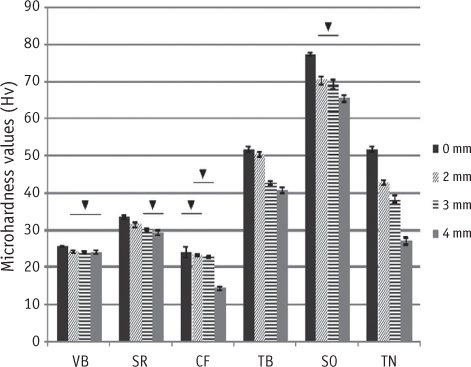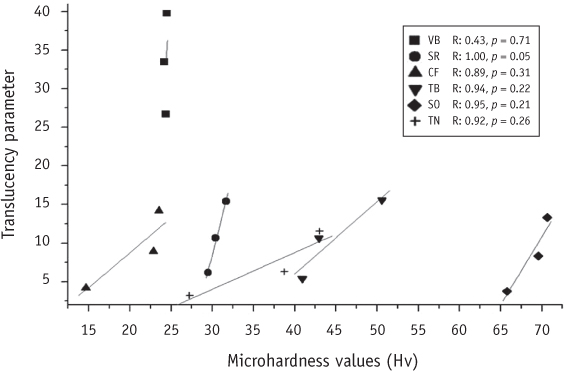Effect of resin thickness on the microhardness and optical properties of bulk-fill resin composites
- Affiliations
-
- 1Department of Conservative Dentistry, School of Dentistry, Pusan National University, Yangsan, Korea. jeongkil@pusan.ac.kr
- 2Department of Dental Materials, School of Dentistry, Pusan National University, Yangsan, Korea.
- KMID: 2148862
- DOI: http://doi.org/10.5395/rde.2015.40.2.128
Abstract
OBJECTIVES
This study evaluated the effects of the resin thickness on the microhardness and optical properties of bulk-fill resin composites.
METHODS
Four bulk-fill (Venus Bulk Fill, Heraeus Kulzer; SDR, Dentsply Caulk; Tetric N-Ceram Bulk Fill, Ivoclar vivadent; SonicFill, Kerr) and two regular resin composites (Charisma flow, Heraeus Kulzer; Tetric N-Ceram, Ivoclar vivadent) were used. Sixty acrylic cylindrical molds were prepared for each thickness (2, 3 and 4 mm). The molds were divided into six groups for resin composites. The microhardness was measured on the top and bottom surfaces, and the colors were measured using Commission Internationale d'Eclairage (CIE) L*a*b* system. Color differences according to the thickness and translucency parameters and the correlations between the microhardness and translucency parameter were analyzed. The microhardness and color differences were analyzed by ANOVA and Scheffe's post hoc test, and a student t-test, respectively. The level of significance was set to alpha = 0.05.
RESULTS
The microhardness decreased with increasing resin thickness. The bulk-fill resin composites showed a bottom/top hardness ratio of almost 80% or more in 4 mm thick specimens. The highest translucency parameter was observed in Venus Bulk Fill. All resin composites used in this study except for Venus Bulk Fill showed linear correlations between the microhardness and translucency parameter according to the thickness.
CONCLUSIONS
Within the limitations of this study, the bulk-fill resin composites used in this study can be placed and cured properly in the 4 mm bulk.
Figure
Cited by 4 articles
-
The effect of different drinks on the color stability of different restorative materials after one month
Neslihan Tekçe, Safa Tuncer, Mustafa Demirci, Merve Efe Serim, Canan Baydemir
Restor Dent Endod. 2015;40(4):255-261. doi: 10.5395/rde.2015.40.4.255.Criteria for clinical translucency evaluation of direct esthetic restorative materials
Yong-Keun Lee
Restor Dent Endod. 2016;41(3):159-166. doi: 10.5395/rde.2016.41.3.159.Color stability of bulk-fill and incremental-fill resin-based composites polished with aluminum-oxide impregnated disks
Uzay Koc-Vural, Ismail Baltacioglu, Pinar Altinci
Restor Dent Endod. 2017;42(2):118-124. doi: 10.5395/rde.2017.42.2.118.Effect of water storage on flexural strength of silorane and methacrylate-based composite resins
Narges Panahandeh, Hassan Torabzadeh, Hani Naderi, Seyedeh Mahsa Sheikh-Al-Eslamian
Restor Dent Endod. 2017;42(4):309-315. doi: 10.5395/rde.2017.42.4.309.
Reference
-
1. Lassila LV, Nagas E, Vallittu PK, Garoushi S. Translucency of flowable bulk-filling composites of various thickness. Chin J Dent Res. 2012; 15:31–35.2. Ilie N, Bucuta S, Draenert M. Bulk-fill resin-based composites: an in vitro assessment of their mechanical performance. Oper Dent. 2013; 38:618–625.
Article3. Czasch P, Ilie N. In vitro comparison of mechanical properties and degree of cure of bulk fill composites. Clin Oral Investig. 2013; 17:227–235.
Article4. Ilie N, Keßler A, Durner J. Influence of various irradiation processes on the mechanical properties and polymerisation kinetics of bulk-fill resin based composites. J Dent. 2013; 41:695–702.
Article5. Flury S, Hayoz S, Peutzfeldt A, Hüsler J, Lussi A. Depth of cure of resin composites: is the ISO 4049 method suitable for bulk fill materials? Dent Mater. 2012; 28:521–528.
Article6. Tanthanuch S, Ruenqsri P, Kukiattrakoon B. Optimal depth of cure for nanohybrid resin composite using quartz tungsten halogen and new high intensity lightemitting diode curing units. Gen Dent. 2013; 61:e14–e17.7. Finan L, Palin WM, Moskwa N, McGinley EL, Fleming GJ. The influence of irradiation potential on the degree of conversion and mechanical properties of two bulk-fill flowable resin composite base materials. Dent Mater. 2013; 29:906–912.
Article8. Price RB, Dérand T, Loney RW, Andreou P. Effect of light source and specimen thickness on the surface hardness of resin composites. Am J Dent. 2002; 15:47–53.9. Ilie N, Hickel R. Investigations on a methacrylate-based flowable composite based on the SDR™ technology. Dent Mater. 2011; 27:348–355.
Article10. Bouschlicher MR, Rueggeberg FA, Wilson BM. Correlation of bottom-to-top surface microhardness and conversion ratios for a variety of resin composite compositions. Oper Dent. 2004; 29:698–704.11. Moore BK, Platt JA, Borges G, Chu TM, Katsilieri I. Depth of cure of dental resin composites: ISO 4049 depth and microhardness of types of materials and shades. Oper Dent. 2008; 33:408–412.
Article12. Yeh CL, Powers JM, Miyagawa Y. Color of selected shades of composites by reflection spectrophotometry. J Dent Res. 1982; 61:1176–1179.13. Inokoshi S, Burrow MF, Kataumi M, Yamada T, Takatsu T. Opacity and color changes of tooth-colored restorative materials. Oper Dent. 1996; 21:73–80.14. Miyagawa Y, Powers JM, O'Brien WJ. Optical properties of direct restorative materials. J Dent Res. 1981; 60:890–894.
Article15. Johnston WM, Reisbick MH. Color and translucency changes during and after curing of esthetic restorative materials. Dent Mater. 1997; 13:89–97.
Article16. Kim IJ, Lee YK. Changes in color and color parameters of dental resin composites after polymerization. J Biomed Mater Res B Appl Biomater. 2007; 80:541–546.
Article17. Lee YK. Influence of filler on the difference between the transmitted and reflected colors of experimental resin composites. Dent Mater. 2008; 24:1243–1247.
Article18. Campbell PM, Johnston WM, O'Brien WJ. Light scattering and gloss of an experimental quartz-filled composite. J Dent Res. 1986; 65:892–894.
Article19. Kim SJ, Son HH, Cho BH, Lee IB, Um CM. Translucency and masking ability of various opaque-shade composite resins. J Dent. 2009; 37:102–107.
Article
- Full Text Links
- Actions
-
Cited
- CITED
-
- Close
- Share
- Similar articles
-
- Color Stability of Bulk-Fill Resin Composites after Immersion in Different Media
- Degree of Conversion and Polymerization Shrinkage of Low and High Viscosity Bulk-Fill Giomer-based and Resin-based composites
- Comparison of Surface Microhardness of the Flowable Bulk-Fill Resin and the Packable Bulk-Fill Resin according to Light Curing Time and Distance
- Color evaluation of low viscosity bulk-fill resin with composite resin capping layer
- Color stability of bulk-fill and incremental-fill resin-based composites polished with aluminum-oxide impregnated disks




